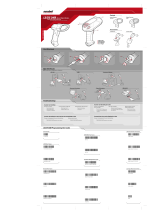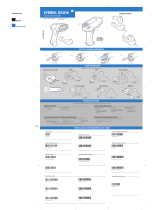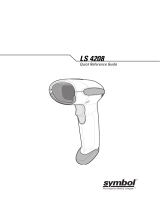Page is loading ...

Symbol LS1203
Quick Reference Guide

2 Symbol LS1203
© 2006-2008 MOTOROLA, INC. All rights
reserved.
Motorola reserves the right to make changes
to any product to improve reliability, function,
or design.
Motorola does not assume any product liability
arising out of, or in connection with, the
application or use of any product, circuit, or
application described herein.
No license is granted, either expressly or by
implication, estoppel, or otherwise under any
patent right or patent, covering or relating to
any combination, system, apparatus,
machine, material, method, or process in
which Motorola products might be used. An
implied license exists only for equipment,
circuits, and subsystems contained in Motorola
products.
MOTOROLA, the Stylized M Logo and Symbol
and the Symbol logo are registered
trademarks of Motorola, Inc. Other product
names mentioned in this manual may be
trademarks or registered trademarks of their
respective companies and are hereby
acknowledged.
Motorola, Inc.
One Motorola Plaza
Holtsville, N.Y. 11742-1300
http://www.motorola.com/enterprisemobility
Warranty
For the complete Motorola hardware product
warranty statement, go to:
http://www.motorola.com/enterprisemobility/warranty
Patents
This product is covered by one or more
patents. For patent information go to:
http://www.motorola.com/enterprisemobility/patents

3
Connect/Disconnect
Cable
Connect Host Interface
Keyboard Wedge Interface
RS-232 Interface
USB Interface
1
2

4 Symbol LS1203
Aim and Scan
3
012345
012345

6 Symbol LS1203
Parts of the Scanner
Scanning Modes
The scanner can operate in two modes:
•
Triggered mode - trigger button must be
pressed to emit the laser in order to a
scan bar code.
or
•
Auto-scan mode - scanner laser is in
constant on state and no trigger button
press is required to scan a bar code.
To toggle between modes, scan
TRIGGERED/AUTO-SCAN bar codes on
page 5.
For example, if the scanner is in triggered
mode, scan AUTO-SCAN MODE to switch
to auto-scan mode. If the scanner is in
auto-scan mode, scan TRIGGERED
MODE to switch to triggered mode.
NOTE When the scanner is
not used for an extended
period of time in auto-scan
mode, it enters sleep mode.
To wake the scanner, press
the trigger button.
LED
Trigger
Button
Scan
Window

7
Troubleshooting
Problem Possible
Cause
Possible
Solutions
Nothing
happens
when the
scan button
is pulled.
No power to
the scanner.
Check system
power. Ensure
power supply is
connected.
Interface or
power
cables are
loose.
Ensure all cable
connections are
secure.
Laser
comes on,
but symbol
does not
decode.
Scanner not
programmed
for correct
bar code
type.
Ensure scanner
is programmed
to read the type
of bar code
scanned. Refer
to the Symbol
LS1203
Product
Reference
Guide, p/n
72E-73953-xx,
for more
information.
Bar code
symbol is
unreadable.
Check the
symbol to
ensure it is not
defaced. Try
scanning
another bar
code type.
Distance
between
scanner and
bar code is
incorrect.
Move scanner
closer to or
further from the
bar code.
Symbol is
decoded but
not
transmitted
to the host.
Scanner not
programmed
for the
correct host
type.
Scan the
appropriate
host type bar
code.

8 Symbol LS1203
Beeper Definitions
The scanner issues different beep
sequences and patterns to indicate status.
The table below defines beep sequences
that occur during both normal scanning and
while programming the scanner.
NOTE For detailed
troubleshooting, refer to the
Symbol LS1203 Product
Reference Guide, p/n
72E-73953-xx.
Beeper
Sequence
Indication
Standard Use
Low/medium/high
beep
Power up.
Short high beep A bar code symbol was
decoded (if decode beeper
is enabled).
4 long low beeps A transmission error was
detected in a scanned
symbol. The data is
ignored. This occurs if a
unit is not properly
configured. Check option
setting.
5 low beeps Conversion or format
error.
Low/high/low
beep
ADF transmit error.
High/high/high/
low beep
RS-232 receive error.
Parameter Menu Scanning
Short high beep Correct entry scanned or
correct menu sequence
performed.

9
Low/high beep Input error, incorrect bar
code or Cancel scanned,
wrong entry, incorrect bar
code programming
sequence; remain in
program mode.
High/low beep Keyboard parameter
selected. Enter value
using bar code keypad.
High/low/high/
low beep
Successful program exit
with change in the
parameter setting.
Low/high/low/
high beep
Out of host parameter
storage space. Scan SET
DEFAULTS on page 86.
Code 39 Buffering
High/low beep New Code 39 data was
entered into the buffer.
3 beeps - long
high beep
Code 39 buffer is full.
Low/high/low
beep
The Code 39 buffer was
erased or there was an
attempt to clear or transmit
an empty buffer.
Low/high beep A successful transmission
of buffered data.
Host Specific
USB only
4 short high
beeps
Scanner has not
completed initialization.
Wait several seconds and
scan again.
Scanner gives a
power-up beep
after scanning a
USB Device
Type.
Communication with the
bus must be established
before the scanner can
operate at the highest
power level.
Beeper
Sequence
Indication

10 Symbol LS1203
LED Definitions
In addition to beeper sequences, the
scanner communicates with the user using
a two-color LED display. The table below
defines LED colors that display during
scanning.
Programming Bar Codes
Descriptions
This guide includes the programming bar
codes required to set up the scanner to
work with various host interfaces. Some
frequently used programming bar codes
are also included.
For all programming bar codes and detailed
information about the scanner, go to:
http://www.symbol.com/services/manuals
The power-up
beep occurs
more than once.
The USB bus may put the
scanner in a state where
power to the scanner is
cycled on and off more
than once. This is normal
and usually happens when
the host PC cold boots.
RS-232 only
1 short high beep A <BEL> character is
received and Beep on
<BEL> is enabled.
LED Indication
Off No power is applied to the scanner,
or the scanner is on and ready to
scan.
Green A bar code was successfully
decoded.
Red A data transmission error or
scanner malfunction occurred.
Beeper
Sequence
Indication

11
and download the latest version of the
Symbol LS1203 Product Reference Guide.
The definitions that follow briefly explain the
programming bar codes that begin on page
86.
Set Defaults
Scan Set Defaults on page 86 to set all
parameters to their default values.
Host Interfaces
NOTE Cables may vary depending on
configuration.
Keyboard Wedge Interface
To use a Keyboard Wedge interface, scan
IBM PC COMPATIBLES page 86. Then
scan the appropriate Country Keyboard
Type (country code).
RS-232 Interface
To use an RS-232 interface, scan an
RS-232 host type beginning on page 88.
USB Interface
The scanner attaches directly to a USB
host, or a powered USB hub, and is
powered by it. No additional power supply
is required. When using a USB interface,
the scanner auto detects the USB and
defaults to the HID keyboard interface. For
additional USB hosts, see page 88.

86 Symbol LS1203
Programming Bar Codes
Keyboard Wedge
Interface
Country Keyboard Types
(Country Codes)
SET DEFAULTS
IBM PC/AT and IBM PC
COMPATIBLES
IBM PS/2 (MODEL 30)
2
5001
5002
5003
5004
5005
5006
5007
5008
5009
5010
7009
7008
7013
7012
7004
7011
7003
7002
7014
NORTH AMERICAN (Default)
FRANÇAIS/FRENCH Windows
FRANÇAIS CANADIAN/
FRENCH CANADIAN Windows 95/98
1

88 Symbol LS1203
RS-232 Interface
RS-232 Interface
USB Interface
STANDARD RS-232
ICL RS-232
NIXDORF RS-232 MODE A
NIXDORF RS-232 MODE B
FUJITSU RS-232
OPOS
HID KEYBOARD EMULATION
IBM HAND-HELD USB

89
Carriage Return/Line Feed
Set Scan Data Transmission Format
Cancel
SCAN OPTIONS
<DATA><SUFFIX>
ENTER
CANCEL

90 Symbol LS1203
Ergonomic Recommendations
Caution: In order to avoid or minimize the potential
risk of ergonomic injury follow the
recommendations below. Consult with your local
Health & Safety Manager to ensure that you are
adhering to your company’s safety programs to
prevent employee injury.
• Reduce or eliminate repetitive motion
• Maintain a natural position
• Reduce or eliminate excessive force
• Keep objects that are used frequently within
easy reach
• Perform tasks at correct heights
• Reduce or eliminate vibration
• Reduce or eliminate direct pressure
• Provide adjustable workstations
• Provide adequate clearance
• Provide a suitable working environment
• Improve work procedures.
Regulatory Information
All Symbol devices are designed to be compliant
with rules and regulations in locations they are sold
and will be labeled as required.
Any changes or modifications to Symbol
Technologies equipment, not expressly approved
by Symbol Technologies, could void the user's
authority to operate the equipment.
Power Supply
Note: Use only a Symbol-approved power supply
(p/n KT-14001-001R, 50-14000-009 or
50-14000-010) output rated 5 VDVC and minimum
650mA. The power supply is certified to EN60950
with SELV outputs. Use of alternative power supply
will invalidate any approval given to this device and
may be dangerous.
Hinweis: Benutzen Sie nur eine von Symbol
Technologies genehmigte Stromversorgung
(Teilenr. KT-14001-001R, 50-14000-009,
50-14000-010) mit einer Ausgangsleistung von 5
VDC (Gleichstrom) und mindestens 650mA. Die
Stromversorgung ist nach EN60950 für die
Verwendung in SELV-Stromkreisen zertifiziert. Bei
Verwendung eines anderen Netzteils werden alle
für das Gerät gewährten Genehmigungen außer
Kraft gesetzt, und der Betrieb kann gefährlich sein.

91
Radio Frequency Interference
Requirements
Note: This equipment has
been tested and found to
comply with the limits for a
Class B digital device,
pursuant to Part 15 of the FCC
rules. These limits are designed to provide
reasonable protection against harmful interference
in a residential installation. This equipment
generates, uses, and can radiate radio frequency
energy and, if not installed and used in accordance
with the instruction manual, may cause harmful
interference to radio communications. However
there is no guarantee that interference will not
occur in a particular installation. If the equipment
does cause harmful interference to radio or
television reception, which can be determined by
turning the equipment off and on, the user is
encouraged to try to correct the interference by one
or more of the following measures:
• Re-orient or relocate the receiving antenna.
• Increase the separation between the
equipment and receiver.
• Connect the equipment into an outlet on a
circuit different from that to which the receiver
is connected.
• Consult the dealer or an experienced
radio/TV technician for help.
Radio Frequency Interference
Requirements - Canada
This Class B digital apparatus complies with
Canadian ICES-003.
Cet appareil numérique de la classe B est
conforme à la norme NMB-003 du Canada.
Marking and European
Economic Area (EEA)
Statement of Compliance
Symbol Technologies, Inc., hereby
declares that this device is in
compliance with all the applicable
Directives, 89/336/EEC, 73/23/EEC. A
Declaration of Conformity may be
obtained from
http://www2.symbol.com/doc/.
Tested to comply
with FCC Standards
FOR HOME OR OFFICE USE

92 Symbol LS1203
Japan (VCCI) - Voluntary Control
Council for Interference
This is a Class B product based on the standard of
the Voluntary Control Council for Interference from
Information Technology Equipment (VCCI). If this
is used near a radio or television receiver in a
domestic environment, it may cause radio
interference. Install and use the equipment
according to the instruction manual.
Laser Devices
Symbol devices using lasers comply
with 21CFR1040.10 and 1040.11
except for deviations pursuant to Laser
Notice No. 50, dated July 26, 2001 and
EN60825-1:1994+ A1:2002 +A2:2001,
IEC60825-1:1993+A1:1997+A2:2001.
The laser classification is marked on one of the
labels on the device.
Class 1 Laser devices are not considered to be
hazardous when used for their intended purpose.
The following statement is required to comply with
US and international regulations:
Caution: Use of controls, adjustments or
performance of procedures other than those
specified herein may result in hazardous laser light
exposure.
Class 2 laser scanners use a low power, visible
light diode. As with any very bright light source,
such as the sun, the user should avoid staring
directly into the light beam. Momentary exposure to
a Class 2 laser is not known to be harmful.
Recommandations
ergonomiques
Attention : pour éviter ou minimiser le risque
potentiel d'une blessure ergonomique, respectez
les recommandations suivantes. Consultez votre
responsable local de l'hygiène, de la santé et de la
sécurité, pour vous assurer que vous respectez les
consignes de sécurité de votre entreprise, qui ont
pour but d'éviter toute blessure d'employé.
Ǩȃ㺙㕂Ȅǃᚙฅ⧚㺙㕂ㄝ䳏⊶䱰ᆇ㞾Џ㽣ࠊन䅄Ӯ˄˲˟˟˥˅
ȃ⑪ȀǺǤȷɱɁ
Bᚙฅᡔ㸧㺙㕂ǼǮDŽǨȃ㺙㕂Ȅǃ
ᆊᒁ⪄๗ǼՓ⫼ǮȠǨǽȧⳂⱘǽǬǻǙȓǮǡǃǨȃ㺙㕂ǡɱ
ɀȲșɎɴɛɀɯɻফֵ″Ȁ䖥ǬǻՓ⫼ǪȡȠǽǃ
ফֵ䱰ᆇȧᓩǢ䍋ǨǮǨǽǡǗȟȓǮDŽ
পᡅ䂀ᯢȀᕧǸǻℷǬǙপȟᡅǙȧǬǻϟǪǙDŽ

95
Marquage et zone économique
européenne (ZEE)
Déclaration de conformité
Symbol Technologies, Inc., déclare par
la présente que cet appareil est
conforme à toutes les Directives
89/336/CEE et 73/23/CEE. Vous
pouvez obtenir une déclaration de
conformité en vous adressant à
http://www2.symbol.com/doc/.
Japan (VCCI) - Voluntary Control
Council for Interference
This is a Class B product based on the standard of
the Voluntary Control Council for Interference from
Information Technology Equipment (VCCI). If this
is used near a radio or television receiver in a
domestic environment, it may cause radio
interference. Install and use the equipment
according to the instruction manual.
Appareils lasers
Les appareils Symbol à rayons laser
sont conformes aux normes
américaines 21CFR1040.10 et 1040.11
à l'exception des déviations
conformément à l'avertissement laser No.50, du 26
juillet 2001 et des normes européennes
EN60825-1:1994+ A1:2002 +A2:2001,
IEC60825-1:1993+A1:1997+A2:200 .
La classification des rayons lasers figure sur l'une
des étiquettes de l'appareil.
Les appareils à rayons laser de classe 1 ne sont
pas considérés comme dangereux, à condition de
les utiliser pour les activités prévues. La
déclaration suivante est nécessaire pour respecter
les réglementations américaines et
internationales:
Attention : L'utilisation de commandes, réglages
ou procédures autres que ceux qui sont spécifiés
dans ce document risque d'entraîner une
exposition dangereuse à des rayons laser.
Ǩȃ㺙㕂Ȅǃᚙฅ⧚㺙㕂ㄝ䳏⊶䱰ᆇ㞾Џ㽣ࠊन䅄Ӯ˄˲˟˟˥˅
ȃ⑪ȀǺǤȷɱɁ
Bᚙฅᡔ㸧㺙㕂ǼǮDŽǨȃ㺙㕂Ȅǃ
ᆊᒁ⪄๗ǼՓ⫼ǮȠǨǽȧⳂⱘǽǬǻǙȓǮǡǃǨȃ㺙㕂ǡɱ
ɀȲșɎɴɛɀɯɻফֵ″Ȁ䖥ǬǻՓ⫼ǪȡȠǽǃ
ফֵ䱰ᆇȧᓩǢ䍋ǨǮǨǽǡǗȟȓǮDŽ
পᡅ䂀ᯢȀᕧǸǻℷǬǙপȟᡅǙȧǬǻϟǪǙDŽ

98 Symbol LS1203
Funkfrequenzen auswirken. Eine Gewährleistung,
dass bei einer bestimmten Installation keine
Störungen auftreten, kann nicht gegeben werden.
Sollte das Gerät Störungen beim Radio- oder
TV-Empfang verursachen, die durch Aus- und
Einschalten des Geräts erkannt werden können,
sollten die Störungen durch eine oder mehrere der
folgenden Maßnahmen behoben werden:
• Neuausrichtung oder Umstellung der
Empfangsantenne
• Vergrößerung des Abstands zwischen Gerät
und Empfänger
• Anschluss des Geräts an eine andere
Steckdose als die, an der der Empfänger
angeschlossen ist
• Beratung durch den Händler oder einen
Radio-/Fernsehtechniker
Radio Frequency Interference
Requirements – Canada
This Class B digital apparatus complies with
Canadian ICES-003.
Cet appareil numérique de la classe B est
conforme à la norme NMB-003 du Canada.
Zeichen und der europäische
Wirtschaftsraum (EWR)
Konformitätserklärung
Symbol Technologies, Inc. erklärt
hiermit, dass dieses Gerät allen
anwendbaren Richtlinien, 89/336/EEC,
73/23/EEC, entspricht. Eine
Konformitätserklärung kann unter
http://www2.symbol.com/doc/
heruntergeladen werden.
Japan (VCCI) - Voluntary Control
Council for Interference
This is a Class B product based on the standard of
the Voluntary Control Council for Interference from
Information Technology Equipment (VCCI). If this
Ǩȃ㺙㕂Ȅǃᚙฅ⧚㺙㕂ㄝ䳏⊶䱰ᆇ㞾Џ㽣ࠊन䅄Ӯ˄˲˟˟˥˅
ȃ⑪ȀǺǤȷɱɁ
Bᚙฅᡔ㸧㺙㕂ǼǮDŽǨȃ㺙㕂Ȅǃ
ᆊᒁ⪄๗ǼՓ⫼ǮȠǨǽȧⳂⱘǽǬǻǙȓǮǡǃǨȃ㺙㕂ǡɱ
ɀȲșɎɴɛɀɯɻফֵ″Ȁ䖥ǬǻՓ⫼ǪȡȠǽǃ
ফֵ䱰ᆇȧᓩǢ䍋ǨǮǨǽǡǗȟȓǮDŽ
পᡅ䂀ᯢȀᕧǸǻℷǬǙপȟᡅǙȧǬǻϟǪǙDŽ

101
obstante, no se garantiza que la interferencia no se
produzca en una instalación determinada. Si el
equipo provoca interferencias en la recepción de
señales de radio o televisión (lo que se puede
averiguar encendiendo y apagando el equipo), se
aconseja al usuario que intente corregir la
interferencia a través de una o varias de las
siguientes medidas:
• Cambie la orientación o la ubicación de la
antena receptora.
• Aumente la separación entre el equipo y el
receptor.
• Conecte el equipo a una toma de un circuito
distinto del utilizado actualmente para la
conexión del receptor.
• Consulte al distribuidor o a un técnico
cualificado de radio / TV para obtener ayuda.
Requisitos sobre interferencias
de radiofrecuencia: Canadá
Este aparato digital de Clase B cumple con la
normativa canadiense ICES-003.
Cet appareil numérique de la classe B est
conforme à la norme NMB-003 du Canada.
Marcas del Espacio Económico
Europeo (EEE)
Declaración de conformidad
Symbol Technologies, Inc. declara que
este dispositivo cumple las
especificaciones de las directivas
pertinentes, 89/336/CEE, 73/23/CEE.
La declaración de conformidad se
puede obtener en
http://www2.symbol.com/doc/.
Japan (VCCI) - Voluntary Control
Council for Interference
This is a Class B product based on the standard of
the Voluntary Control Council for Interference from
Information Technology Equipment (VCCI). If this
is used near a radio or television receiver in a
Ǩȃ㺙㕂Ȅǃᚙฅ⧚㺙㕂ㄝ䳏⊶䱰ᆇ㞾Џ㽣ࠊन䅄Ӯ˄˲˟˟˥˅
ȃ⑪ȀǺǤȷɱɁ
Bᚙฅᡔ㸧㺙㕂ǼǮDŽǨȃ㺙㕂Ȅǃ
ᆊᒁ⪄๗ǼՓ⫼ǮȠǨǽȧⳂⱘǽǬǻǙȓǮǡǃǨȃ㺙㕂ǡɱ
ɀȲșɎɴɛɀɯɻফֵ″Ȁ䖥ǬǻՓ⫼ǪȡȠǽǃ
ফֵ䱰ᆇȧᓩǢ䍋ǨǮǨǽǡǗȟȓǮDŽ
পᡅ䂀ᯢȀᕧǸǻℷǬǙপȟᡅǙȧǬǻϟǪǙDŽ
/




